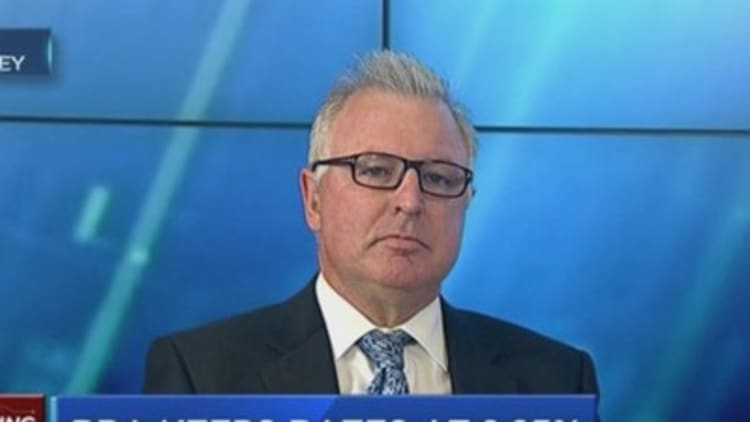
The Reserve Bank of Australia (RBA) has chosen to put off a cut in interest rates, announcing Tuesday that borrowing costs will remain at a record low of 2.25 percent.
The news sent the Australian dollar surging 1 percent to $0.7697, as markets had priced in an 80 chance of a rate cut. The benchmark S&P ASX 200 stock index pulled back to trade 0.4 percent higher after rising more than 1 percent earlier.
In the statement accompanying the decision, the central bank said that further easing might be appropriate as data suggests the economy continues to grow at a below-trend pace. It also noted that growth in lending to housing investors appears stagnant.
The decision brought swift criticism from analysts expecting a rate cut. They cite the value of the Aussie dollar, which still appears high when compared with plummeting iron ore prices, which fell below $50 metric ton last week for the first time in 10 years.
Iron ore accounts for a fifth of the value of Australia's total exports and some commentators reckon the Aussie, which has fallen 20 percent fall against the U.S. dollar since last June to trade at $0.75 currently, is still too strong to bolster demand for the commodity.
"By deciding not to cut interest rates today from the current level of 2.25 percent, the Reserve Bank of Australia missed an opportunity to achieve the further weakening in the Australian dollar that it so badly crave," according to a research note from Paul Dales, chief Australia & NZ economist at Capital Economics.
But he notes that the RBA statement does provide a strong hint that rates will be lowered next month.
"The RBA will probably cut rates to 2.0 percent in May and then sit back for a few months to see how the economy evolves. By the middle of the year, however, we think it will be clear that the economy needs more help," Dales added. He expects two more cuts which will bring borrowing costs to 1.5 percent by year end.
Others who predicted no change in monetary policy said the RBA was likely waiting for more information around Sydney's red-hot property market, as well as the latest employment and inflation data which are due later this month.
"We are looking for May and the simple reason is those inflation figures at the end of the month, might as well look at those and other jobs and retail sales figures before cutting interest rates. So I don't think there is any rush to cut interest rates again," Craig James, chief economist at CommSec, told CNBC before the decision.
The RBA has been under pressure to support an economy hit by a slowdown in its vast resources sector, with leading business groups warning of a looming "economic despair."
"It perplexes me a little bit. I know people talk about waiting for the CPI numbers in late April. That's the exact reason why its perplexing for me. Iron ore is still under stress, coal is a forgotten commodity, it's still under stress. All these things are dragging down our national income," Tony Farnham, economist & analyst at Patersons Securities, told CNBC.

